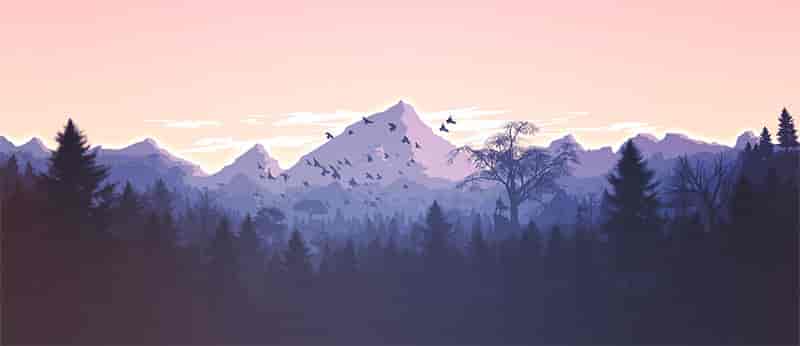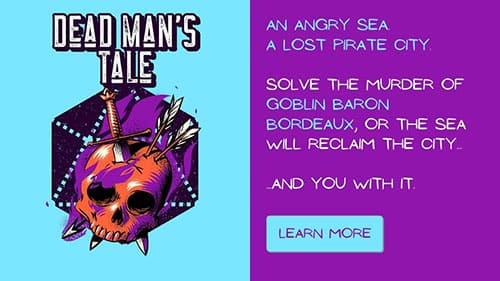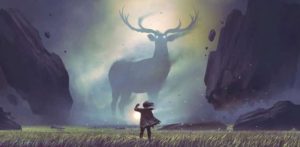Consider the following forest encounter and campaign options for DnD 5e and Pathfinder adventures:
- Make survival a priority and keep track: food, water, shelter.
- Are we being hunted?
- Hunt for rare herbs—try the sick character hook.
- Include survival encounters around rivers and lakes.
- Make the forest haunted.
Forest encounters and campaigns for DnD 5e or Pathfinder should include elements of survival, the concepts of hunting and being hunted, and an assortment of ecologies to vary the adventure. The woods are as classic to fantasy adventure as it gets. However, in games that often revolve around dungeon crawling, the forest can often be skipped over or relegated to quick travel.
Classic forest monsters include beasts, lycanthropes, goblinoids, owlbears, ogres, blights, green hags, giant insects, dryads, treants and even the undead.
If you’re interested in a premade adventure with island jungles and pirate ghosts, check out my original Dead Man’s Chest. Click here or below to learn more.
Make survival a priority and keep track: food, water, shelter.
Players should keep track of food and water supplies and consider natural perils like weather and wildlife. Often, details like food and water can be overlooked in a campaign. Game runners don’t want to keep badgering their players to stay hydrated.
However, when it comes to forest journeys, leaning into the need for food, water and shelter can bring an element of reality to the adventure. Include moments for the party to forage or hunt. These basic needs are crucial and will give the party something to do other than walk. Rangers, druids, bards and wizards will shine here.
Food
The party can certainly buy food rations from a nearby town, at least to begin the journey. However, cranking up the survival aspects of the forest can offer fun, creative options for the game. Consider hunting, foraging or even fishing.
So, what do these suggestions actually look like?
Hunting involves Survival or Perception checks to find prey, Stealth checks to close in and successful attack rolls. Obviously, a ranger character could take care of the bow hunting. However, rogues, bards, druids and wizards—anyone who could cast invisibility—could accomplish this task. Druids could simply shift into a large predator and spare the party the use of arrows.
Foraging can be done through basic Perception, Nature or Survival checks. Include opportunities to find herbs for potions, medicine or poisons for those interested.
Fishing takes a little imagination, especially if we’re starting from scratch and don’t have a fishing pole. If no fishing pole is available, players will have to get creative and use Survival checks to build one. A potential spearing situation could work this way as well. There are several methods out there for fishing mechanics, but consider the following for a basic concept:
- Use a Survival check to cast and get a bite. Perception can work for spears only (in shallow water)
- Dexterity checks of 12 or 13 to hook and reel, depending on fish size.
- Roll 1d6 for randomized fish species—make one a monster for fun
- Roll 1d4 for size.
Water
Water is a bit more straightforward—you need it every day. Fortunately, the forest is a place with plenty of natural springs, running rivers, creeks and standing water bodies.
Related Posts:
Guide to Building Underground Campaigns: DnD 5e
| Guide to Building Dinosaur Adventures: DnD 5e
|
Players will need to jump on the chance to refill waterskins when the opportunity arises, as this resource will dwindle. We can make it more difficult than anticipated, forcing players to consider a normally overlooked necessity. Spellcasters and characters close to nature could use magical means of locating water in dry spots.
I wouldn’t recommend killing the party with dehydration, but pressing the matter can keep players on their toes.
Shelter
Weather events often complicate travel and survival, so we could cause a need for creative problem solving. With rain or storms, the party will need to either seek a premade shelter or make their own. A nearby cave, abandoned cabin or rocky overhang can offer a quick fix to the problem. However, our players may find danger with this quick fix.
Of course, small caves are classic homes to bears. So, we could spice up this trope with an owlbear, basilisk, or another forest-dwelling predator. We could even throw in a subterranean creature like a hulking bulette or giant worm if you’re feeling crazy.
Abandoned cabins can offer spooky options to the game. We could consider ghosts and the undead, or perhaps stumble across an ancient tome of curses. You know what I mean—Evil Dead style. These abandoned structures can also be opportunities to plant story elements. Therefore, our players could have a space to investigate.
Are we being hunted?
Add a sense of danger to your forest by showing your players signs their being hunted. Strange noises in the night, footprints, a foreboding sense from a magically sensitive character, all could increase tension in your forest adventure. In many ways, this game style is like the movie Predator: not even a team of warriors is safe from this hunter.
After a few tension-inducing clues, this predator can strike without warning. However, try not to murder your players out of nowhere. During an investigation or exploration moment in the game, our monster can make its presence known. Allow it to strike and disappear so the players can feel the tension of the threat.
This monster could take many forms and might need homebrewing to crank up the threat level, consider:
- Lycanthropes—a classic werewolf, werebear or werecat
- Bug Monsters—ankheg, spiders, carrion crawler, drider
- Shapeshifters—oni, changelings, elementals
- Hags—green hags or night hags, witches are scary and magical
- Large Predators—such as owlbears or green dragons
- Demons—so many to choose from. Choose one that thematically fits the forest to haunt a particular wilderness
- NPC bounty hunters
Hunt for rare herbs—try the sick character hook.
McGuffins can add a focus to your campaign, and this classic story trope or herb hunting causes a sense of immediacy to the mission.
The setup? We take a character who is important to the story (or has powerful emotional impact) and make them ill. The cure to this illness or poison can only be found in one place, a harrowing section of the dark forest. Consider the following setups.
A magical flower grows in the forgotten grove of the fairy forest. The rare herb can make a potion capable of curing anything. Melody, a young girl in the nearby village, has fallen to plague of dark magic. To get to these flowers, we must past through a dangerous forest full of Fay monsters and reach the grove. This grove is protected by blights or dryads—plantlike beings in charge of the flowers.
On the other hand, we could place these flowers on top of a mountain, where the altitude is necessary for the plant to grow. However, the mountain forest is roamed by ogres and goblinoids such kobolds, goblins, hobgoblins or gnolls. The party must confront sudden storms, roaming ogres and natural pitfalls as they climb the mountain and retrieve the flower.
Include survival encounters around rivers and lakes.
Water environments can shake up a forest campaign with different scenery and encounters. After trekking miles through a maze of trees, your party can come across a raging river or an expansive lake. Now, we have opportunities to explore.
Rivers
Using a river, we can cut off our party’s forward progress and present a problem to solve. The raging white water is too wide to jump, but they must make it to the other side. What kind of opportunities could we present that would add to the adventure?
- A creaky, old swinging bridge stretches from one side to the other
- An abandoned canoe sits at the edge of the river
- River boulders present a skill check to hop across the river
Let’s use the canoe option and take a ride down the river. How would we play this out in an RPG?
First, we need rowers on each side of the boat making Athletics or Strength checks. Let’s say each ability check places the party 30 feet down river. If one side fails the check, the boat drifts in that direction. We can create the difficulty of these checks as the river becomes more or less intense. Also, we’ll need someone navigating in the back of the boat, using Survival checks to steer.
Now, we should talk about monster encounters, as rivers present interesting options. As I mentioned before, fishing could end up in a battle instead of a meal. So, what sort of creatures would show up in a forest river?
- Bullywug or Giant Frog/Frog monster
- Kuo-toa /Fish folk
- Water weird or water elemental
- Bog Hag
- Kappa
Lake
Lakes are perfect for parties to relax while a threat lurks in the depths beneath. We could pull from the lore of lake monsters to set the party up for an interesting monster encounter. With a well-placed rowboat, the players will need to discuss if crossing the body of water is a smart idea. They’ve already ran into monsters in the woods. Will they suspect a threat in the water?
Lake threats could include:
- Plesiosaurus
- Hydra (if you’re feeling frisky)
- Froghemoth
Make the Forest Haunted
Haunted forests can hold so many options for monsters and adventures—between treants, undead, dark Fay, ghosts of the wood, green hags and goblins, we can create a hostile and spooky environment. Campaigns will often begin in small towns, giving the players simple quest options to level up and learn how to work together. From these typical small towns, we can enter woodlands and locations of legend with strange and haunted legacies.
Let’s take a look at a couple of haunted forest questlines.
The Hag Hunt
We can take an example straight from real life folklore and have our players hunt a woods witch. Perhaps this hag has been abducting local village children, or maybe she has set a curse on the town. Either way, the party can either begin in such a town or come across this forgotten town along their journey.
The witch should be some sort of hag, potentially with henchmen or monsters at her command. Normally, this witch has a lair in the woods—a cabin, cave or decrepit tree she calls home. Ogres and treants make for exciting encounters on the way to slay the witch. Once the hag is encountered, players will have a magical opponent to deal with alongside bruisers like trolls, treants and ogres.
Related Posts:
Guide to Building Desert Campaigns: DnD 5e
| Guide to Building a Druid Circle of the Moon: DnD 5e
|
The Ghost Story
Yet another fun haunted forest storyline, I could send my party on a quest to solve a haunting within a forest setting. Often, these quests include undead monsters and the search for a hidden item. This item could be a key, a letter, the scene of a crime, anything that may right a wrong or lead the party to a hidden truth.
Consider using everything from zombies, revenants and mummies to ghosts, poltergeists and banshees to terrify your players as they search for truth. These types of stories can easily engage players with mysteries to unfold and tense, scary locations to explore. A retrieval style mission could include a lost village or doomed caravan remains. Maybe try a cave. Those are always spooky.
So, what did I miss?
What are other ways we could incorporate the forest into our campaign?
There are certainly more ways to incorporate gameplay in a forest setting. Sometimes we get a glimpse of inspiration in the moment. Sometimes, the idea hits us in the middle of the workweek. Either way, developing the adventure for our friends is worth it. We are the worldbuilders.
Let me know in the comments section below.






